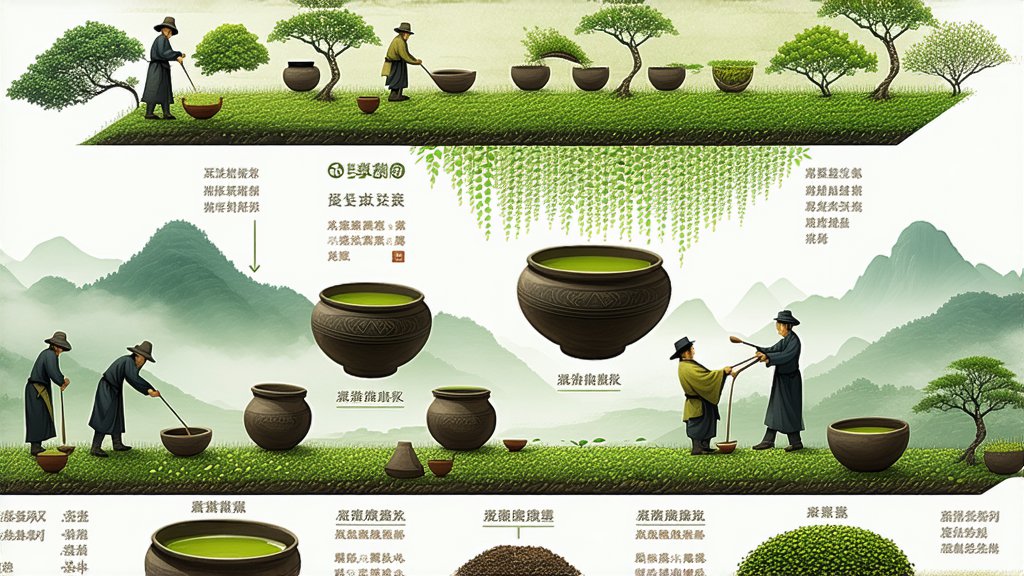
Pu-erh tea, a gem within China's vast tea culture, stands as a testament to the country's rich historical tapestry and profound understanding of nature's bounty. Originating from the Yunnan Province, this unique variety of black tea has captivated tea enthusiasts worldwide with its complex flavors, health benefits, and the intriguing aging process that transforms it over time. In this exploration, we delve into the depths of Pu-erh tea, unraveling its history, varieties, meticulous production methods, and the art of tasting that elevates it beyond mere beverage to a cultural experience.
A Glimpse into History
The story of Pu-erh tea dates back over a millennium, with its roots intertwined with the ancient Tea Horse Road, a trade route that connected Yunnan to Tibet and beyond. It is said that the tea was named after the market town of Pu'er, where it was traded and compressed into cakes for easier transportation along these treacherous paths. Over centuries, Pu-erh has evolved, absorbing influences from various cultures and becoming a symbol of Chinese tea craftsmanship.
Varieties of Pu-erh Tea
Pu-erh tea is broadly categorized into two main types: raw (Sheng) and ripe (Shou). Each type undergoes a distinct processing method, resulting in unique flavors and aging potentials.
-
Raw Pu-erh (Sheng): This variety is made from sun-dried green tea leaves that are then steamed and compressed into shapes such as bricks, cakes, or pu-erh balls without undergoing artificial fermentation. Raw Pu-erh is prized for its ability to age and transform over decades, developing deeper, more complex flavors with hints of orchid, fruit, and earthiness.
-
Ripe Pu-erh (Shou): In contrast, ripe Pu-erh undergoes a post-fermentation process known as "wet piling," where piles of tea are kept humid and warm to accelerate microbial activity, mimicking the natural aging process. This results in a mellower, earthier taste with notes of caramel, wood, and sometimes a slight medicinal undertone. Ripe Pu-erh is often enjoyed younger but can also develop complexity with age.
The Art of Production
The production of Pu-erh tea is an art form that marries tradition with precision. Here’s an overview of the key steps involved:
-
Harvesting: Tea leaves are handpicked during specific seasons, typically spring and autumn, when they are at their freshest and most flavorful.
-
Withering: Freshly picked leaves are spread out to wilt under the sun, reducing moisture content and softening the leaves for rolling.
-
Fixation: For raw Pu-erh, leaves are briefly steamed to halt oxidation, preserving their green character. Ripe Pu-erh skips this step as it relies on microbial fermentation instead.
-
Rolling: Leaves are rolled into tight spirals, enhancing extraction during brewing and contributing to the tea's unique texture.
-
Drying: Rolled leaves are dried to further reduce moisture, preparing them for compression.
-
Compression (for Sheng): Raw Pu-erh leaves are weighed, steamed again to soften, and then pressed into molds to form cakes, bricks, or other shapes before being dried thoroughly.
-
Fermentation (for Shou): Ripe Pu-erh undergoes a controlled fermentation process, where piles of tea are kept damp and warm for several weeks to months, fostering microbial growth that imparts its distinctive flavor profile.
-
Aging: Both raw and ripe Pu-erh benefit from proper storage conditions—cool, dry, and free from strong odors—to mature gracefully over time.
The Tasting Experience
Tasting Pu-erh tea is a sensory journey that requires attention to detail and an appreciation for subtlety. Here's a guide to savoring every sip:
-
Preparation: Use a Yixing clay teapot or a Gaiwan, both traditionally favored for their ability to enhance the tea's flavor. Rinse the leaves briefly with hot water to 'wake' them up.
-
Infusion: Steep the tea in water heated to around 90-95°C (195-205°F) for raw Pu-erh and slightly cooler for ripe Pu-erh. Start with shorter steeping times (about 5-10 seconds) and gradually increase as subsequent infusions reveal different facets of the tea's character.
-
Observation: Note the color of the liquor, which can range from bright amber for young Sheng to deep red-brown for aged Shou. The aroma should be assessed both from the wet leaves and the brewed tea, identifying floral, fruity, earthy, or woody notes.
-
Tasting: Sip slowly, allowing the tea to coat your palate. Pay attention to the initial taste, mid-mouth feel, and the lingering aftertaste. Look for complexity, balance, and a smooth finish. With each infusion, the tea reveals new layers of flavor.
-
Appreciation: Reflect on the tea's journey—its origins, the hands that crafted it, and the transformation it has undergone. This mindful approach deepens the connection between the drinker and the centuries-old tradition embodied in every cup of Pu-erh.
In conclusion, Pu-erh tea is more than just a beverage; it's a living testament to China's tea heritage, a bridge between past and present, and a gateway to understanding the profound relationship between nature, culture, and human creativity. Whether you're a seasoned tea connoisseur or a curious newcomer, exploring the world of Pu-erh promises a rich and rewarding experience.